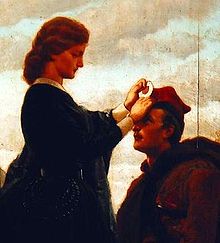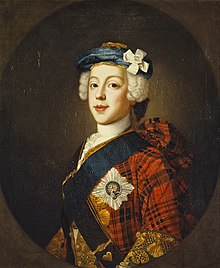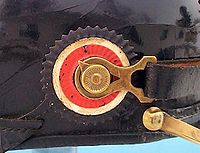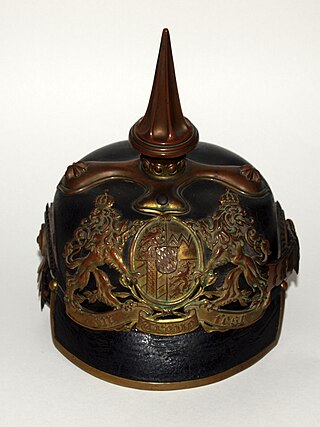
The Pickelhaube, also Pickelhelm, is a spiked leather or metal helmet that was worn in the 19th and 20th centuries by Prussian and German soldiers of all ranks, firefighters and police. Although it is typically associated with the Prussian Army, which adopted it in 1842–43, the helmet was widely imitated by other armies during that period. It is still worn today as part of ceremonial wear in the militaries of certain countries, such as Sweden, Chile, and Colombia.

A slouch hat is a wide-brimmed felt or cloth hat most commonly worn as part of a military uniform, often, although not always, with a chinstrap. It has been worn by military personnel from many different nations including Australia, Ireland, the United Kingdom, Canada, India, New Zealand, Southern Rhodesia, France, the United States, the Confederate States, Germany and many others. Australia and New Zealand have had various models of slouch hat as standard issue headwear since the late Victorian period.

The kepi is a cap with a flat circular top and a peak, or visor. In English, the term is a loanword from French: képi, itself a re-spelled version of the Alemannic German: Käppi, a diminutive form of Kappe, meaning "cap". In Europe, the kepi is most commonly associated with French military and police uniforms, though versions of it were widely worn by other armies during the late 19th and early 20th centuries. In North America, it is usually associated with the American Civil War, as it was worn by soldiers on both sides of the conflict.

The tricorne or tricorn is a style of hat that was popular during the 18th century, falling out of style by 1800, though not called a "tricorne" until the mid-19th century. During the 18th century, hats of this general style were referred to as "cocked hats". At the peak of its popularity, the tricorne varied greatly in style and size, and was worn not only by the aristocracy, but also as common civilian dress, and as part of military and naval uniforms. Typically made from animal fiber, the more expensive being of beaver-hair felt and the less expensive of wool felt, the hat's most distinguishing characteristic was that three sides of the brim were turned up (cocked) and either pinned, laced, or buttoned in place to form a triangle around the crown. The style served two purposes: first, it allowed stylish gentlemen to show off the most current fashions of their wigs, and thus their social status; and secondly, the cocked hat, with its folded brim, was much smaller than other hats, and therefore could be more easily tucked under an arm when going inside a building, where social etiquette dictates that a gentleman should remove his hat. Tricornes with laced sides could have the laces loosened and the sides dropped down to provide better protection from the weather, sun, and rain.

A military uniform is a standardised dress worn by members of the armed forces and paramilitaries of various nations.

A bearskin is a tall fur cap derived from mitre caps worn by grenadier units in the 17th and 18th centuries. Initially worn by only grenadiers, its usage was extended to several other military units in the 19th century. The bearskin cap continued to see use in battle during the mid-19th century, although by the 20th century, its use was limited as a headgear reserved for parade dress. In the 21st century, the bearskin cap is retained by select military units as a prominent element of their ceremonial and full dress uniforms.
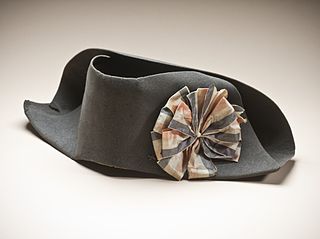
The bicorne or bicorn (two-cornered) is a historical form of hat widely adopted in the 1790s as an item of uniform by European and American army and naval officers. Most generals and staff officers of the Napoleonic period wore bicornes, which survived as widely-worn full-dress headdress until the 20th century.

The pith helmet, also known as the safari helmet, salacot, sola topee, sun helmet, topee, and topi is a lightweight cloth-covered helmet made of sholapith. The pith helmet originates from the Spanish military adaptation of the native salakot headgear of the Philippines.
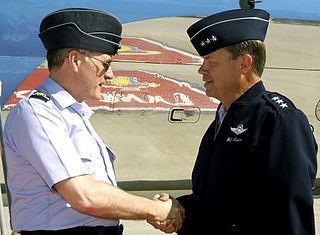
A side cap is a military cap that can be folded flat when not being worn. It is also known as a garrison cap or flight cap in the United States, wedge cap in Canada, or field service cap in the United Kingdom; or in vulgar slang as a cunt cap. In form the side cap is comparable to the glengarry, a folding version of the Scottish military bonnet. It has been associated with various military forces since the middle of the 19th century, as well as various civilian organizations.

A peaked cap, peaked hat, service cap, barracks cover, or combination cap is a form of headgear worn by the armed forces of many nations, as well as many uniformed civilian organisations such as law enforcement agencies and fire departments. It derives its name from its short visor, or peak, which was historically made of polished leather but increasingly is made of a cheaper synthetic substitute.
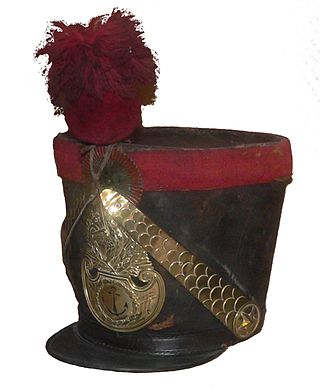
A shako is a tall, cylindrical military cap, usually with a visor, and sometimes tapered at the top. It is usually adorned with an ornamental plate or badge on the front, metallic or otherwise; and often has a feather, hackle, or pompom attached at the top.
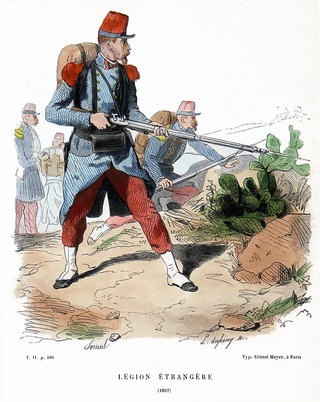
A casquette d'Afrique was a type of lightweight military headgear generally used by the French metropolitan and colonial armies from the early 1830s to the 1860s.
The uniforms of the United States Army distinguish soldiers from other service members. U.S. Army uniform designs have historically been influenced by British and French military traditions, as well as contemporary U.S. civilian fashion trends. The two primary uniforms of the modern U.S. Army are the Army Combat Uniform, used in operational environments, and the Army Green Service Uniform, worn during everyday professional wear and during formal and ceremonial occasions that do not warrant the wear of the more formal blue service uniform.

A sailor cap is a round, flat visorless hat worn by sailors in many of the world's navies. A tally, an inscribed black silk ribbon, is tied around the base which usually bears the name of a ship or a navy. Many navies tie the tally at the rear of the cap and let the two ends hang down to the shoulders as decorative streamers. In the Royal Navy the tally is tied off in a bow over the left ear and in the early 20th century it was customary when going on shore leave to tie a small coin in the bow to make it stand out. In wartime, as a security measure, many navies replace the name of the ship with a generic title. The cap may be further embellished with a badge, cockade or other accessory. Visorless caps of this kind began to be worn in the mid 19th century.

Troops began wearing berets as a part of the headgear of military uniforms in some European countries during the 19th century; since the mid-20th century, they have become a component of the uniforms of many armed forces throughout the world. Military berets are usually pushed to the right to free the shoulder that bears the rifle on most soldiers, but the armies of some countries, mostly within Europe, South America, and Asia, have influenced the push to the left.

Diplomatic uniforms are ornate uniforms worn by diplomats—ambassadorial and consular officers—at public occasions. Introduced by European states around 1800 and patterned on court dress, they were abandoned by most countries in the twentieth century, but diplomats from some countries retain them for rare, formal occasions.

In the period from 1918 to 1935 of the young Soviet Union any "bourgeois" military ideas were put under general suspicion by the communists, the new political establishment. Amongst other things, this led to the old tsarist ranks being replaced with a new tradition of rank designations and insignia for the new Red Army and the nascent Soviet Navy.

The extensive system of uniforms of the Russian Armed Forces was inherited from the Soviet Armed Forces and modified across the years.

The cockade of Italy is the national ornament of Italy, obtained by folding a green, white and red ribbon into a plissé using the technique called plissage (pleating). It is one of the national symbols of Italy and is composed of the three colours of the Italian flag with the green in the centre, the white immediately outside and the red on the edge. The cockade, a revolutionary symbol, was the protagonist of the uprisings that characterized the Italian unification, being pinned on the jacket or on the hats in its tricolour form by many of the patriots of this period of Italian history. During which, the Italian Peninsula achieved its own national unity, culminating on 17 March 1861 with the proclamation of the Kingdom of Italy. On 14 June 1848, it replaced the azure cockade on the uniforms of some departments of the Royal Sardinian Army, while on 1 January 1948, with the birth of the Italian Republic, it took its place as a national ornament.

The cockade of France is the national ornament of France, obtained by circularly pleating a blue, white and red ribbon. It is composed of the three colors of the French flag, with blue in the center, white immediately outside and red on the edge.
